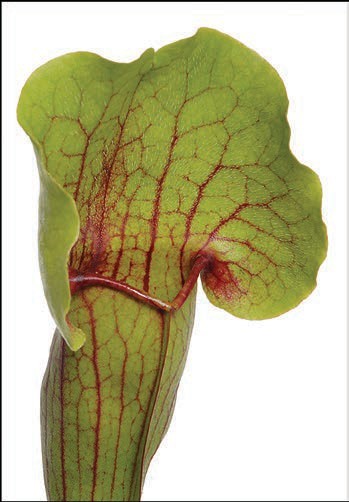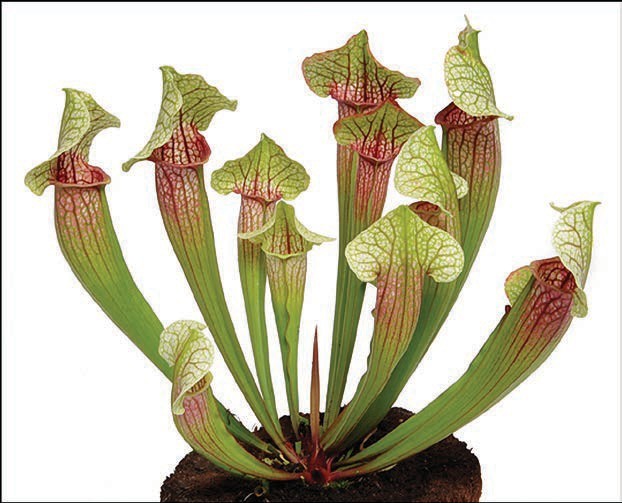|
Carnivorous Plant Newsletter
Volume 43, Number 3, December 2014, pages 135 - 137
New Cultivars
Dionaea ‘Sirius’
Sarracenia ‘Vogel’
Sarracenia ‘Eva’
Dionaea ‘Sirius’
Submitted: 25 March 2014
I found Dionaea ‘Sirius’ in April 2012 at Karnivores located in Colmar, France. The plant was labeled “dentate clone 2”.
Dionaea ‘Sirius’ differs from Dionaea muscipula ‘Blanche Hermine’ in a number of important ways. Dionaea muscipula ‘Blanche Hermine’ is all white and because of a deficiency of chlorophyll is a slow grower. In contrast, the early spring traps of Dionaea ‘Sirius’ start with a red/ pink color (Fig. 1). As the season progresses, the color of new traps fade gradually, becoming white during summer. Only the traps become white. The petioles stay green, which permits the plant to remain vigorous from photosynthesis.
I named this cultivar ‘Sirius’, the brightest white star.
The unique characteristics of Dionaea ‘Sirius’ remain stable with rhizome division and must be propagated vegetatively.
—Christophe Boiteux • Besançon • France • chris.boiteux@live.fr
 
Figure 1: Dionaea ‘Sirius’. Note the red/pink colored early spring trap in the lower center of the left photo. Later in the season, the traps are white with green petioles.
Sarracenia ‘Vogel’
Submitted: 22 August 2014
About 7 years ago René van Kessel from Carniflora nursery, The Netherlands, was happy to inform me about two new Sarracenia cultivars he had made; “Among the various resulting seedlings, I observed 2 samples from different batches and selected them for further observation”. When they showed promising features they were taken into tissue-culture from where they have been multiplied. Both cultivars, Sarracenia ‘Vogel’ and S. ‘Eva, have successfully been made available for the past three years.
While the exact parentage of Sarracenia ‘Vogel’ is unknown, both S. flava and S. purpurea subsp. venosa var. burkii influence are present and back-crossing may have been involved due to visual characteristics. This stout, solid cultivar produces 5-7 new leaves about 28 cm tall throughout the season, lasting up to 7 months. The bulging pitchers are green with red longitudinal veins and more heavily veined in the upper part. The large wide hood is heavily veined but more pronounced on the inner side, with a slight undulated margin while the inner surface is abundantly covered with little bristly hairs (Fig. 2). The interior of the hood develops a red coloration with darker veining, while the outside stays mainly green making it most distinctive. The pitcher tube and especially the interior of the hood become suffused with red as it matures, while the green exterior of the hood becomes a background for red veining only.
This cultivar looks somewhat like a S. × catesbaei cross but with the sides of the large broad hood clearly folded inwards, giving the plant a robust and almost bizarre appearance. The flower petals are pale yellowish-green, but may show occasional pink highlights while the scent is typical and strong reminding of S. flava.
The cultivar’s name honors Mr. Art Vogel in celebration of his retirement as hortulanus of the Leiden Botanical Garden in The Netherlands, and because of his great interest and knowledge of carnivorous plants.
Sarracenia ‘Vogel’ must be reproduced vegetatively to preserve the characteristics of the cultivar.
—Hans Luhrs • Krayenhoffstr. 51 • 1018RJ Amsterdam • The Netherlands • hanlu050@gmail.com
 
Figure 2: Sarracenia ‘Vogel’, not yet fully colored. Photos by Mascha Hendricks.
Sarracenia ‘Eva’
Submitted: 22 August 2014
Although the exact parentage of Sarracenia ‘Eva’ is unknown, according to the given information, one of the parents is most likely a S. ‘Juthatip Soper’, a S. × mitchelliana back-crossing with S. leucophylla. Much of the latter’s features are well visible in this cultivar, producing 6-8 new leaves up to 28 cm long throughout the season and lasting for as long as 7-8 months. They taper gradually from bottom to top to produce a broad cone with a wide almost heart-shaped hood, of which the side lobes are somewhat folded backwards while the inner surface is abundantly covered with little bristly hairs. The pitchers are primarily green, apart from a few red longitudinal veins, with whitish- pink fenestrations in the upper part below the mouth. The hood is very white fenestrated onto a light green background with red veins pronounced on the inner side of the hood (Fig. 3). As the pitchers mature the color in the upper part becomes dark pink, especially the interior and the mouth, while the green inner side of the hood becomes a background for dark red veins. The combination of a dark pink upper part of the pitcher and white-mottled green hood gives this cultivar a unique appearance. The flower petals are deep red.
The cultivar’s name was chosen to honor the late Mrs. Els Vogel-Adamse for her culinary adventures during board meetings of the Dutch carnivorous plant society as well as her work behind the scene. She also had used this name to sign her outstanding Ndebele paintings.
Sarracenia ‘Eva’ must be reproduced vegetatively to preserve the characteristics of the cultivar.
—Hans Luhrs • Krayenhoffstr. 51 • 1018RJ Amsterdam • The Netherlands • hanlu050@gmail.com
 
Figure 3: Sarracenia ‘Eva’. Photos by Mascha Hendricks.
|

